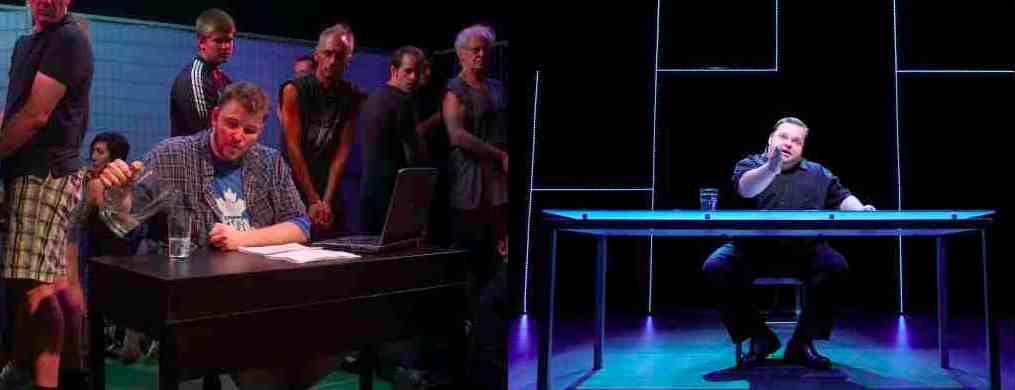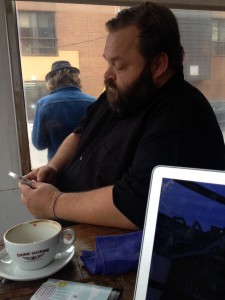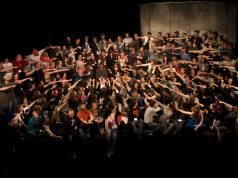
Mike Daisey had a pretty significant impact on my theatre company for someone I had never met.
At Praxis Theatre, I first remember learning about him through an article published in Seattle that was circulating the internet called, The Empty Spaces Or, How Theater Failed America. It’s about a lot of things, but integrally the death of the repertory theatre system. Daisey went on to turn this article into a successful show, which ironically ended up being a big hit in NYC. It struck a chord with me, as six years earlier when I completed my MFA at The American Repertory Theatre they went from a resident company of fourteen local actors, to five, with most individual roles cast out of New York.
We discovered Daisey in the early days of the The Praxis Blog, when it was on Blogspot and was called Theatre is Territory (2006-08). Daisey was also doing his thing on mikedaisey.com, so I got to know a lot more of his ideas about theatre as arts investment focused on institutions and not artists. In particular, how buildings, organizations and their administrative staff have done a lot better than theatre artists over the past two decades.
This was exactly the type of thing we liked to cover and expand upon on our site, so we would not only link to his articles, but even write some of our own that responded to him or co-opted his ideas. Of particular interest to me was his connection between American MFA programs and Ponzi Schemes, in terms of what they asked you to pay to join the system, and what sorts of wages you could make upon graduation. I even titled one of my many posts lamenting Luminato’s unwillingness to invest in local artists, “How Luminato Failed Toronto”, which contained sentences like “Mike Daisey is right and it’s the same situation up here.”
The other way he impacted Praxis was through his work as a monologuist. I saw his The Agony and The Ecstacy of Steve Jobs at The Public Theatre in NYC during a miracle two weeks I spent mostly reading and writing in The Occupy Wall Street Library. I found it revelatory as an artist running a theatre company dedicated to praxis: Here was art about essential questions of labour and rights in a contemporary context and powerful theatrical form, in hopes of bringing about change. Praxis. It was my first standing ovation in years. When we began workshopping Tommy Taylor’s G20 Toronto play You Should Have Stayed Home, after some experiments and some frank notes we decided to scrap the plan of staging the narrative physically and allow it to come through storytelling. That Daisey could thrive so successfully with some notes, a desk and a water pitcher, gave us confidence we could do the same. So we did.

Of course, the use of this aesthetic came back to bite us in the ass when the scandal broke that several of the events Daisey had framed as having seen in The Agony and the Ecstacy were actually events reported by other people. At the time, his interview with Ira Glass on the topic of the show’s accuracy was NPR’s most downloaded podcast. It remains one of the few ‘theatre controversies’ that I can recall breaching mainstream consciousness. This disappointed me big-time – not only because I had believed in the show so much, but also because I had used the same aesthetic for a show where many terrible things also happened, and Tommy Taylor really did see them all.
Eventually I got over it though. Daisey put up a pretty good fight and probably the net-result of the controversy was increased awareness of Apple’s labour practices. So the show still achieved an impressive degree of praxis. No one ever argued that any of the things in the show didn’t happen. The distinction that Daisey didn’t see a few of them personally probably diminished the work, but makes no difference in terms of social justice.
The other thing that won me back was the openness with how he handled it – by making his script open-source and inviting anyone anywhere to edit and produce the show for free as they liked. It took Mitchell Cushman, who invited Daisey with Crow’s Theatre to Toronto to put on a show about Rob Ford that opens tonight, about three seconds to mount his own version of The Agony starring David Ferry in the Passe Muraille backspace. Mitchell’s version even included excerpts from comments on his blog post on The Praxis Blog about the controversy, which was an interesting meta-surprise for an Artistic Director.
The comment that wasn’t included in the show was the one that really brought me back around to Daisey – the one Daisey left himself – where he apologized and expressed genuine distress about the impact he may have had on documentary theatre. I think that’s really what was needed and after that I was ready to move on. Nobody’s perfect: not Ford, not Daisey; certainly not me.
Anyways after all this, Mike Daisey and I finally got to have a chat on Twitter, using #DaiseyTO. Below is what we and others talked about.









